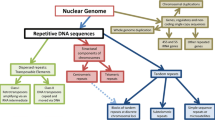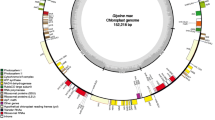Abstract
THE introduction of foreign mitochondria or mitochondrial DNA into a cell is a useful technique for clarifying the molecular mechanisms responsible for the maintenance of mitochondria. Novel combinations of mitochondrial and nuclear genomes have been studied in mammalian cells in culture1–6 and in yeast7,8,14,15. In Drosophila, we have recently constructed heteroplasmic flies possessing both endogenous mitochondrial DNA and foreign mitochondrial DNA by intra- and interspecific transplantation of germ plasm9. During the maintenance of these heteroplasmic lines, flies of D. melanogaster are produced that no longer possess their own mitochondrial DNA but retain the foreign mitochondrial DNA from D. mauritiana. These flies are fertile and the foreign mitochondrial DNA is stably maintained in their offspring. Here we report the complete replacement of endogenous mitochondrial DNA with that from another multicellular species. Molecular and genetic analysis of this replacement in Drosophila should provide new insight into the functional interaction between nuclear and organelle genomes.
Similar content being viewed by others
References
De Francesco, L., Attardi, G. & Croce, C. M. Proc. natn. Acad. Sci U.S.A. 77, 4079–4083 (1980).
Giles, R. E., Stroynowski, I. & Wallace, D. C. Som. cell Genet. 6, 543–554 (1980).
Hayashi, J.-I., Tagashira, Y., Yoshida, M. C., Ajiro, K. & Sekiguchi, T. Exp. cell Res. 147, 51–61 (1983).
White, F. A. & Bunn, C. L. Mol. gen. Genet. 197, 453–460 (1984).
Zuckerman, S. H., Solus, J. F., Gillespie, F. P. & Eisenstadt, J. M. Som. cell Genet. 10, 85–92 (1984).
King, M. P. & Attardi, G. Cell 52, 811–819 (1988).
Fox, T. D., Sanford, J. C. & McMullin, T. W. Proc. natn. Acad. Sci. U.S.A. 85, 7288–7292 (1988).
Johnston, S. A., Anziano, P. Q., Shark, K., Sanford, J. C. & Butow, R. A. Science 240, 1538–1541 (1988).
Matsuura, E. T., Chigusa, S. I. & Niki, Y. Genetics 122, 663–667 (1989).
Lemeunier, F., David, J. R., Tsacas, L. & Ashburner, M. The Genetics and Biology of Drosophila (eds Ashburner, M, Carson, H. L. & Thompson J. N. Jr) Vol. 3e, 218–222 (Academic, London, 1986).
Mahowald, A. P. J. exp. Zool. 167, 237–262 (1962).
Satta, Y., Ishiwa, H. & Chigusa, S. I. Molec. biol. Evol. 4, 638–650 (1987).
Solignac, M., Monnerot, M. & Mounolou, J.-C. J. molec. Evol. 23, 31–40 (1986).
Kotylak, Z., Lazowska, J., Hawthorne, D. C. & Slonimski, P. P. Achievements and Perspectives of Mitochondria! Research Vol. II (eds Quagliariello, E., Slater, E. C., Palmieri, F., Saccone, C. & Kroon, A. M.) 1–20 (Elsevier, Amsterdam, 1985).
Wenzlau, J. M., Saldanha, R. J., Butow, R. A. & Perlman, P. S. Cell 56, 421–430 (1989).
Author information
Authors and Affiliations
Rights and permissions
About this article
Cite this article
Niki, Y., Chigusa, S. & Matsuura, E. Complete replacement of mitochondrial DNA in Drosophila. Nature 341, 551–552 (1989). https://doi.org/10.1038/341551a0
Received:
Accepted:
Issue Date:
DOI: https://doi.org/10.1038/341551a0
- Springer Nature Limited
This article is cited by
-
Selfish drive can trump function when animal mitochondrial genomes compete
Nature Genetics (2016)
-
Selective propagation of functional mitochondrial DNA during oogenesis restricts the transmission of a deleterious mitochondrial variant
Nature Genetics (2014)
-
Postglacial species displacement in Triturus newts deduced from asymmetrically introgressed mitochondrial DNA and ecological niche models
BMC Evolutionary Biology (2012)
-
Evidence of animal mtDNA recombination between divergent populations of the potato cyst nematode Globodera pallida
Genetica (2012)
-
Paternal leakage of mitochondrial DNA in experimental crosses of populations of the potato cyst nematode Globodera pallida
Genetica (2011)





